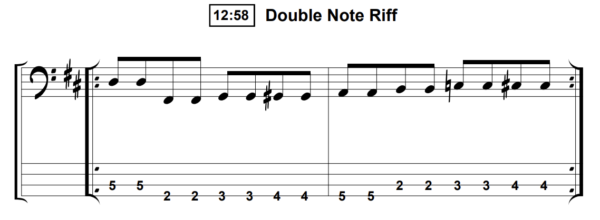This week is the first in a 3 part series covering the topic of 4 finger picking on bass guitar. This lesson covers the basics of free stroke picking with 2 fingers then we’ll be adding an extra finger each week.
Four-Finger Picking
In this lesson, we are going to begin learning how to incorporate the use of all four right-hand fingers into our playing. You may have heard this technique reffered to as free stroke – this tends to be a description of the motion of the fingers and how we hold the hand, while four-finger picking is a description of the number of fingers you have available for use.
This free stroke/claw hammer style of playing has been around for a long time and is very similar to the finger-picking method used by flamenco and classical guitarists.
Advantages of Four-Finger Picking
- Easier to play quickly
- Allows you to move between techniques
- Hand is in position to add percussive notes
- Easy to palm mute
First Things First – Positioning
- Headstock slightly raised rather than level with the bass
- Right arm bent at a right-angle
- Rest lower wrist on heal of bass
- Curl fingers around like a claw and pull away from the strings to pluck a note
The numbering of each finger is as follows:
Index – 1
Middle – 2
Ring – 3
Pinky – 4
Easy One-Note Exercise Using The Thumb and Finger
The quickest way to get to grips with this technique is to practise getting a solid rhythm going on one note. Start slowly and get the 8th notes consistent whilst alternating between the right-hand thumb and first finger.
Note: Muting can be a bit of an issue when playing in this way as the thumb is not there to dampen the strings. If you find the E string getting in the way and resonating a lot then you can try muting with the fretting hand instead. When you fret the D on the 5th fret of the A string, let the rest of the finger holding the note lie gently across the other string – gently though as you don’t want any other notes sounding out.
This next exercise is a simple chromatic walking bass line that is perfect for practising alternating thumb and finger due to every note being doubled.
To make it slightly harder, try dropping the double notes and playing the basic groove. You have to cross strings more often with this one so keep it slow and make sure you are doing it correctly before moving on.
Building Finger Speed
It takes a while to get familiar with any new technique, but eventually the muscle memory will start to take over as you internalise common movements. Try playing any bass lines, scales, arpeggios or anything you know using this technique. Let’s start with a simple C major scale starting on the 8th fret of the E string.
Try extending this scale to two octaves for a longer workout.
Funky Riff
This riff is great for practising the new technique in a fun and musical way. It also shows how you can use this fingerpicking approach in styles other than classical music.
















Wow……what a great lesson Mark….thanks!! I’m a trained classical guitarist and picked up the bass a few years ago!! I always felt there was a connection between the two instruments and styles with right hand technique and this solidifies that intuition!! Thanks again for making the lesson easy to understand and the technique attainable!!
Thanks Mark, as usual a very good lesson.
William